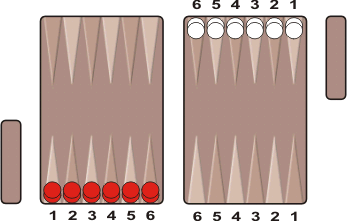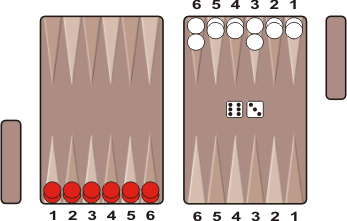![[Backgammon Galore!]](/gif/GaloreButton.gif)
|
|
Backgammon Variants Setup: The players have twelve checkers each. The checkers are stacked in pairs on the six points in the opposite right-hand table as shown below:
To start: Each player rolls one die. The player rolling the higher number goes first and then rolls both dice again to start his first turn. Unstacking the piles: The first goal is to unstack your checkers. To do this, you roll the dice and the numbers showing on the dice are the point numbers to be unstacked. For example, if you roll 6-3, you unstack the checkers in the 6-point and on the 3-point.
If you roll doubles, you only get to unstack one pile, but you also get to roll again. And if you roll doubles again, you play that number and roll again, etc. The game continues with the players taking turns. If a number is rolled corresponding to a point where the checkers have already been unstacked, that part of the roll is lost. Restacking the piles: When all of your piles have been unstacked in this way, you may begin restacking them. This works the same way, by rolling the numbers corresponding to the points to be restacked. Bearing off: Finally, when all of your piles have been restacked, you may begin bearing off. Again, you must roll the numbers corresponding to the points to be borne off. The first player to bear off all of his checkers wins the game.
References
|
![]()
Backgammon Galore : Variants


